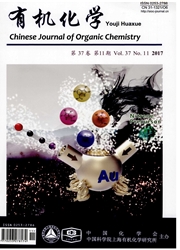

 中文摘要:
中文摘要:
1,2,3-三氮唑芳香寡聚体可以通过分子内三中心C—H···O氢键诱导形成折叠或螺旋二级结构.通过~1H NMR实验研究这类人工二级结构在氯仿和二氯甲烷中进一步形成分子间C—H···Cl~-和C—H···N氢键的倾向性,发现分子内的两类C—H···O氢键可以通过进一步形成C—H···Cl~-氢键而被弱化.在过量Cl~-存在时,三氮唑N-1侧的六元环C—H···O氢键被显著破坏,由此形成分子间C—H···Cl~-氢键,从而诱导骨架形成另一类更加扩展的折叠构象.过量的Br~-和I~-也可以形成类似的分子间氢键.对其中一个八聚体研究揭示,1,2,3-三氮唑螺旋体的内侧2,3-位N原子还可以与三炔和二炔衍生物的炔基C—H形成分子间弱的C—H···N氢键,三氮唑折叠结构通过诱导N原子形成环形定位促进这一分子间弱氢键产生协同效应.
 英文摘要:
英文摘要:
1,2,3-Triazole aromatic oligomers are driven by intramolecular three-center C—H···O hydrogen bonding to form folded or helical secondary structures. This paper reports the assessment of their ability to form intermolecular C—H···Cl~-in CDCl3 or C—H···N hydrogen bonding in CD2Cl2 by using ~1H NMR. It is revealed that the two kinds of intramolecular six-membered C—H···O hydrogen bondings of the backbones are both weakened by Cl~-through the formation of intermolecular C—H···Cl~-hydrogen bonding. In the presence of excess of Cl~-, the C—H···O hydrogen bonding on the N-1 side of the triazole units is, to a large extent, broken by intermolecular C—H···Cl~-hydrogen bonding, which induces the backbones to form another kind of more extended crescent secondary structures. Under similar conditions, excess of Br~-and I~-can also form similar intermolecular hydrogen bonding. It is also found that the inside-located N-2 and N-3 atoms of the triazole units of a 8-mer oligomer can also form weak intermolecular C—H···N hydrogen bonding with C—H atoms of the alkynyl units of several tri-and bi-alkynes, which is enhanced by the folded conformation of the oligomer through forcing the N-2 and N-3 atoms to arrange into a ring.
 同期刊论文项目
同期刊论文项目
 同项目期刊论文
同项目期刊论文
 期刊信息
期刊信息
